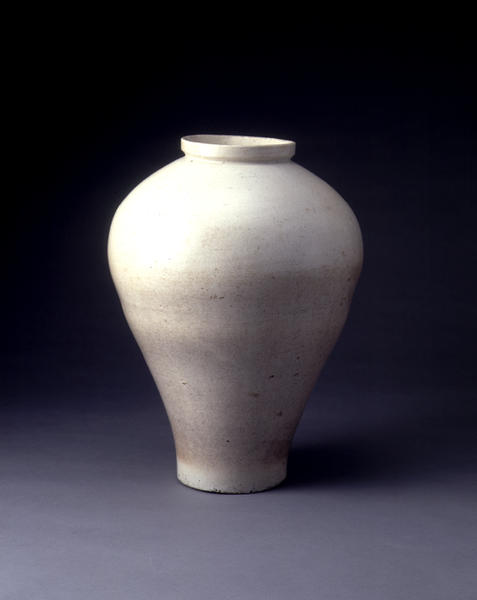白磁大壺
- 朝鮮王朝時代
- 17c
- 白磁製
- H-57 D-43
解説(春の玉手箱)
仏教を国教とした高麗王朝に続いて成立した李氏朝鮮王朝では、儒教が国教となり、清浄・清廉・潔白といった観念を重んじる思想から、焼物の世界でも青磁に変わり白磁が主流となった。朝鮮王朝時代の白磁壺はこの壺のような立壺と、一名「提灯壺」と呼ばれる円壺とがあり、この壺は立壺の中でも大型に属する。口造りは下部で肩口に向かって絞められた力強い特徴ある形で、豊かに張り出したボリューム感のある肩から底部に向かって一気に窄まってゆくラインが美しい。柔らかな釉調から中期でも比較的早い時期のものと考えられる。長年の使用による浸みが静かな立ち姿に一層の深みを与えている。
Catalogue Entry
Korea's Koryo dynasty had Buddhism as its state religion, while the succeeding Yi dynasty established Confucianism as its state religion. Confucianism is a philosophy which reveres purity, innocence, and integrity, and this love of purity was reflected in the change from a predominantly celadon ceramic production to a focus on white porcelains. The white porcelain jars created during the Yi dynasty were either tall, as here, or a round jar shaped dubbed a “lantern jar." This jar is a large example of the tall form. The mouth construction, with its lower section constricting to the shoulder attachment, gives the jar a strong shape, and the expansive swell of the torso and its sense of volume then flows in a lovely line to the narrower base. The soft glaze texture indicates that the jar is mid‐period, though relatively early within that designation. The long years of use have given the jar a patina that heightens its sense of quiet depth.
